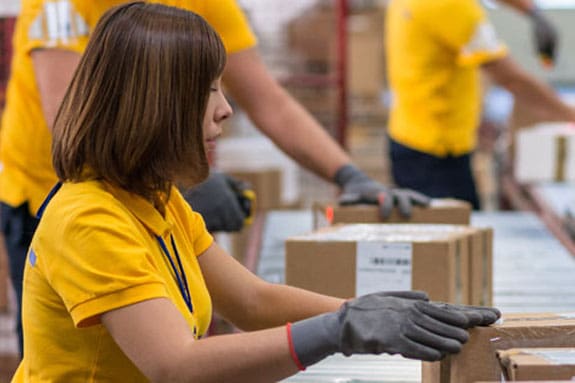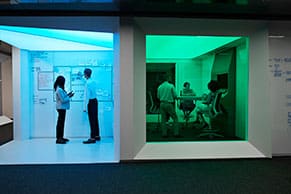Customers have come to expect fast delivery and low prices, putting even more pressure on businesses already trying to proactively address supply chain challenges—namely, rising material costs, geopolitical instability, and increasingly complex logistics networks. Traditionally, logistics operations have had to rely on disconnected systems that don’t provide the visibility and coordination businesses now need to deliver products on time and at reasonable prices. By integrating critical logistics functions, such as procurement and warehousing, companies can better balance these pressures and gain competitive advantages. This article explores the ins and outs of integrated logistics and provides practical strategies on how to reduce costs and accelerate order fulfillment.
What Is Integrated Logistics?
Integrated logistics is an approach to supply chain management that coordinates all logistics functions—transportation, warehousing, inventory management, order fulfillment, and distribution—under one system. Integrated logistics breaks down data and management silos to align operations and gain better control of the flow of goods from their initial procurement through final delivery. This practice replaces previously isolated departments and processes with a holistic system, giving managers end-to-end visibility and control of their entire logistics network. Businesses can use the resulting unified view to strengthen their supply chain operation, rather than having to address isolated inefficiencies or simply moving bottlenecks downstream.
Key Takeaways
- Integrated logistics combines formerly siloed supply chain functions into a unified system to rein in costs and refine order fulfillment.
- Components that lend themselves to integration are inventory, warehousing, transportation, order fulfillment, procurement, IT, and customer service.
- Integration challenges often center on high costs, data security, employee resistance, and technical complexity.
- Integrated logistics grants managers real-time visibility that hones forecasting skills and increases the flexibility needed for swift responses to changing market conditions.
Integrated Logistics Explained
Integrated logistics allows supply chain and operations managers to oversee a synchronized operation, rather than dealing with separate departments one at a time. When a customer places an order, for example, integrated logistics systems automatically check and update inventory levels, notify the relevant warehouse, and suggest optimal picking routes and shipping methods, all while updating stakeholders in real time. This eliminates the delays and errors that stem from independently operated departments that manually hand off information before beginning the next step in the supply chain.
Beyond the improvement in operational efficiency, companies with integrated logistics can sharpen their forecasts regarding customer demand, allowing them to respond more quickly to market changes. They can also make more accurate delivery promises, optimize inventory levels, and minimize handling and carrying costs—all without hindering their ability to meet demand. The visibility behind integrated logistics also helps managers resolve bottlenecks, predict potential disruptions, and allocate resources to areas where they’ll have the greatest impact on customer satisfaction and profitability.
Components of Integrated Logistics
Integrated logistics systems bring together seven customarily isolated core supply chain components under one management roof. Each component plays a specific role in getting goods from suppliers to customers, yet each one shares data and resources with the other components to create a smoother operation. This interrelationship is illustrated below through a running example of a camping gear retailer. By understanding how these components work together, logistics managers can identify integration opportunities and guide investments in ways that strengthen their business’s supply chain infrastructure.
Inventory Management
Integrated inventory management tracks companywide stock levels from the time raw materials are received to the point where finished goods arrive at distribution centers. When new stock arrives, inventory systems connect directly with warehousing and order fulfillment to move inventory through the appropriate links of the supply chain. The integrated logistics system then merges this data into demand forecasts, supplier lead times, and safety stock requirements to automate reordering and approval workflows. This creates a proactive approach to inventory that alleviates stockout risks without tying up unnecessary capital in unsold inventory and storage costs.
For example, if the camping gear retailer’s inventory runs low ahead of a busy summer season, the system will automatically reorder stock on the basis of seasonal sales expectations, current warehouse capacity, and supplier lead times.
Warehousing
Warehousing handles storage, picking, packing, and shipping activities in the logistics network. Integrated systems optimize warehouse layouts and picking routes according to ecommerce order patterns, automatically assigning orders to the facility best suited to delivery timelines and size. Data sharing among warehouses prevents duplication of safety stock, balances fulfillment pressures during peak periods, and allows managers to assess capacity and performance of their entire warehousing network, share best practices, and replicate successes.
When our camping gear retailer receives inventory, its integrated logistics system automatically sends items to storage locations based on sales velocity and distance to high-demand regions, thus guaranteeing that items will continue to be accessible during busy seasons.
Supply Chain
The supply chain component manages relationships and data exchanges with external vendors, manufacturers, and distribution partners. By integrating internal logistics systems with partners’ platforms, companies can align purchases with production schedules to achieve real-time shipment tracking. This collaboration allows businesses to build stronger relationships with their partners and to quickly adjust forecasts to mitigate supply chain risks.
Continuing with the camping gear retailer example, its system receives advance shipping notices from its international tent manufacturers and reserves dock space as containers move through customs. If shipments are delayed, the system automatically adjusts delivery promises to customers and, if necessary, identifies alternative suppliers so the company can still fulfill rush orders.
Order Fulfillment
Order fulfillment manages the process from the moment a customer makes a purchase to final order delivery. With an integrated logistics system, an automated order routing function sends product and customer information to the right fulfillment center based on inventory availability, shipping costs, and delivery expectations, then sends updates to customers and the business at each checkpoint. This integrated delivery approach helps businesses control shipping and handling costs while accelerating fulfillment cycles.
When a customer orders a tent from the example camping gear retailer, the logistics system instantly reserves inventory at the nearest warehouse and selects the carrier that can most cost-effectively satisfy the customer’s delivery preferences.
Procurement
Procurement logistics reduces lead times and simplifies ordering by automatically selecting suppliers that meet predetermined criteria, such as shipping times, past performance, and prices. The integrated system then routes approvals to appropriate users or makes automated purchases that conform with current inventory levels and expected marketplace demand. Integrated logistics systems also connect procurement with warehouse and finance functions to schedule deliveries and manage payment terms, respectively.
The camping gear retailer’s procurement component monitors stock levels for popular items and automatically orders from preferred suppliers that uphold appropriate thresholds to capture volume discounts, which increases profit margins for each sale.
IT and Systems Integration
IT and systems integration connects all logistics components through APIs and real-time data flow. This unified technical infrastructure eliminates redundant data entry, cuts down on errors, and unlocks more robust analytics capabilities. Managers and executives access these analytics in customizable dashboards to monitor performance across multiple sales channels and distribution models.
For our camping retailer, IT systems provide ecommerce platforms and point-of-sale systems that present up-to-date inventory counts and connect warehouses with shipping carriers to oversee performance at each step as goods and materials move through the supply chain.
Customer Service
The customer service module leverages logistics data from other components to enable instant order visibility and to unlock proactive or self-service issue resolution. With access to real-time order information, service representatives can help customers quickly resolve their issues, eliminating call transfers and repetitive questions that frustrate customers and hurt retention. Integrated logistics systems help limit customer service calls—and, therefore, wait times—by providing automated order updates and accurate delivery estimates.
When camping gear customers contact the retailer’s support department, customer service agents can immediately view their orders, identify the source of any delays, offer alternatives, and expedite pertinent replacements from the nearest warehouse—all from a single system.
Integrated Logistics Benefits
Integrated logistics gives companies immediate cost savings and long-term competitive advantages, both of which are especially desirable in today’s highly competitive ecommerce world. Indeed, according to Körber’s 2023 report on the state of shipping and returns, 84% of customers “never return” after one poor delivery experience. This is where the value of integrated logistics systems comes in. The following six core benefits of integrated logistics help companies stay responsive as market forces evolve and customers’ delivery expectations continue to rise:
- Lower costs: Integrated logistics eliminates redundant tasks, optimizes transportation routes, and automates manual processes to keep expenses down. Additionally, the software consolidates shipments, allocates inventory to lower carrying costs, and pares labor requirements, further contributing to a stronger bottom line.
- Improved delivery times: Real-time coordination between warehouses and carriers unlocks faster order processing and fulfillment. Automated systems select the most efficient location and shipping method/carrier (air, ground, third-party delivery, etc.), updating stakeholders at each step.
- Enhanced visibility: Centralized dashboards provide complete oversight of inventory, orders, and shipments across the supply chain. Role-based controls allow users to view exactly what they need for every task, be it big-picture analysis of key performance indicators (KPIs) or granular item- or location-specific insights.
- Better collaboration: Integrated logistics systems create shared digital spaces and data exchange among partners and departments. These collaborative platforms help avoid miscommunications and allow businesses to quickly coordinate and react to disruptions and market changes.
- Stronger demand forecasting: By integrating sales, inventory, market, and financial data, forecasters can generate more accurate predictions related to future demand and supply needs. Procurement and warehouse teams can then act on these predictions to prevent stockouts and overstocks.
- Increased efficiency: Automated and integrated workflows eliminate manual handoffs between departments, as well as redundancies in data entry. This interconnectivity standardizes processes and squelches delays, allowing staff to focus on higher-value initiatives that bolster the order-to-delivery cycle.
Challenges of Integrated Logistics
While integrated logistics can bring significant benefits, companies often encounter obstacles during initial implementation and with ongoing management. In fact, 92% of the 610 operations and supply chain managers surveyed in PwC’s “2025 Digital Trends in Operations Survey” report that their “tech investments haven’t fully delivered the expected results.” Proactive anticipation of and planning for the following four primary challenges help businesses develop realistic timelines, budgets, and change management strategies to make the most of their investments:
- Implementation costs: Initial investments in software licenses, systems integration, and infrastructure upgrades can add up, especially for large operations. To tame these costs, many companies implement cloud-based logistics systems, which don’t call for the same infrastructure investments that accompany on-premises systems. When deploying a new system, companies must also consider indirect costs, such as consulting fees, process redesigns, training, and potentially expensive disruptions arising during the transition period.
- Data security and privacy: Connecting multiple systems and sharing data with partners can introduce cybersecurity vulnerabilities and add new compliance requirements, particularly when sharing information with external partners, including vendors and third-party logistics (3PL) companies. Any integrated logistics system should incorporate strong security protocols, encryption, user training, and role-based access controls that align with—or exceed—industry regulations.
- Training and user adoption: Employees accustomed to legacy systems often resist new, integrated platforms, limiting the new system’s ability to fully integrate departmental data. Managers can increase buy-in among warehouse workers, office staff, and management by clearly communicating the benefits of the new system through extensive training and change management programs.
- Integration complexity: Connecting disparate systems, often from different vendors with unique data formats and protocols, creates technical implementation hurdles. Custom APIs or middleware solutions can help systems achieve real-time data synchronization. Businesses can avoid this challenge by implementing an all-in-one ERP system with integrated logistics capabilities.
What Systems and Tools Enable Integrated Logistics?
Many successful integrated logistics systems rely on five key technologies that work together to connect disconnected departments in a unified logistics network. Not every company’s logistics network requires all five; the number will depend on the company’s needs and budgetary limitations. By understanding each technology and how each one contributes to a comprehensive framework, businesses can choose the right tools for their specific operation.
Enterprise Resource Planning (ERP)
ERP systems act as a central hub for the logistics network by connecting finance, inventory, purchasing, and operations functions in one system. ERP users can access up-to-date inventory, order, and financial data from the warehouse floor, home office, while in-transit, or from anywhere with an internet connection, especially with cloud-based platforms. This accessibility helps teams standardize business processes and data formats and connect core data with specialized logistics applications, such as warehouse and transportation management systems.
Warehouse Management Systems (WMS)
WMS platforms automate inventory tracking and optimize floor plans to make the most of space and picking routes. These systems use barcode scanning, RFID tracking, and mobile devices to manage the flow of goods within a warehouse to minimize incorrect orders and fulfillment times. Advanced WMS solutions integrate with ERP, transportation, and ecommerce systems to update inventory counts, coordinate shipments, and process multichannel orders. They can also connect with robotic equipment, such as pickers and scanners, to automate additional aspects of order fulfillment.
Internet of Things (IoT)
IoT sensors and devices monitor shipments, equipment, and environmental conditions to give more detailed updates than is possible with simple tracking. For example, temperature sensors check on refrigerated goods, GPS trackers follow shipments in transit, and warehouse sensors detect equipment issues. The resulting continuous data stream feeds into ERP and WMS platforms, triggering automated alerts if conditions fall outside acceptable ranges. In addition, ongoing oversight can help indicate when to schedule predictive maintenance before equipment failures disrupt operations.
Artificial Intelligence (AI)
Modern AI algorithms can analyze large logistics data sets to predict demand and fine-tune shipping routes and warehouse layouts more accurately than traditional forecasting methods. These models continuously learn by identifying subtle patterns in historical sales, weather data, and market trends and comparing them to real results as they come in. AI systems use these insights to suggest proactive improvement strategies, such as making ongoing inventory adjustments, rerouting shipments to skirt potential disruptions, and identifying opportunities to negotiate better rates with suppliers.
Electronic Data Interchange (EDI)
EDI is a standardized communication method for business partners that automates important logistics information exchanges, including purchase orders, invoices, shipping notices, and other documents. By eliminating manual entry and paper-based communications, EDI can process information in seconds, especially when it’s integrated with ERP platforms. These systems also securely maintain records from data sources across the logistics network, creating a paper trail for payment workflows, audits, returns, and insurance claims.
Modernize Your Transportation and Logistics With NetSuite
Managing logistics for multiple systems introduces data silos and delays that can prevent businesses from meeting customer expectations. NetSuite’s cloud-based transportation and logistics platform unites procurement, warehouse, inventory, shipping, distribution, and financial data in a single ERP system. The software enhances logistics management by automating payment processes, providing real-time visibility across all logistics functions, and by integrating with 3PL providers, including shipping carriers and ecommerce channels. With NetSuite’s built-in analytics capabilities and role-based dashboards, logistics managers can track KPIs and reach data-driven decisions that help to rein in costs while accelerating fulfillment cycles. NetSuite’s customizable modules allow the system to scale alongside a business as it expands into new markets, adds distribution centers, or increases order volumes—without requiring large infrastructure investments or extended downtime periods.
Modern integrated logistics networks replace previously fragmented operations with unified systems that use a single management framework to smoothly move goods from suppliers through warehouses to customers. Companies that integrate their logistics operations position themselves to satisfy rising customer expectations and build more agile processes that can adapt to evolving needs as the business grows. Successful integration requires careful planning, the right technologies, and a deliberate approach to change management. But the endeavor can lead to lasting competitive advantages: lower costs, faster fulfillment, and data-driven decision-making, all serving to tame increasingly complex supply chain networks.
#1 Cloud ERP
Software
Integrated Logistics FAQs
What’s the difference between logistics and integrated logistics?
In traditional logistics, companies manage transportation, warehousing, and distribution as separate functions, each with its own systems and processes. Integrated logistics unifies these functions under a single framework where components share real-time data and work together to manage the entire supply chain, not just individual components.
What’s an example of integrated logistics?
When a customer places an order from a retailer’s ecommerce site, an integrated logistics system automatically coordinates the entire fulfillment process within seconds. The system checks inventory across all warehouses, chooses the nearest location, sends picking instructions, books the optimal shipping carrier, and provides tracking information—all without human intervention.
What does integrated logistics support do?
Integrated logistics support provides companies with the technology infrastructure and ongoing management they need to connect and maintain a unified logistics system. Support teams can be internal IT professionals or experts provided by system vendors. Their responsibilities include implementing software platforms, establishing data standards, training staff, and continuously refining processes to make sure every component works toward the same goal—namely, a smooth transfer of goods from supplier to customer.








